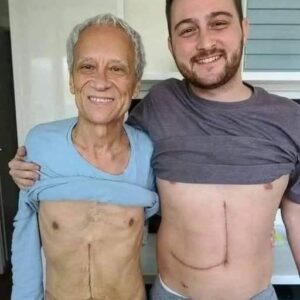A Hollywood Legend Reborn
For more than three decades, Julia Roberts has been a name synonymous with brilliance, sincerity, and cinematic magic. Her performances in beloved classics like Pretty Woman, Notting Hill, and My Best Friend’s Wedding defined an era of optimism and charm in Hollywood storytelling. Yet, beyond the laughter and sweeping romance, Roberts has always possessed the rare ability to reveal the depth of human experience with emotional honesty.
In her gripping portrayal of Barbara Weston in August: Osage County, Roberts transcends her established image, embracing a role that strips away glamour and demands vulnerability. Gone are the dazzling smiles and designer gowns — replaced by a woman burdened by family tension, grief, and the painful duty of confronting her past.
What emerged was not just a performance but a masterclass in authenticity — a study of pain, love, and resilience that proves Julia Roberts continues to evolve not merely as a movie star, but as one of cinema’s most empathetic storytellers.
The Decision to Transform
When Roberts first read the script for August: Osage County, she reportedly knew the character of Barbara Weston would be one of her most difficult challenges yet. Barbara is not the idealized heroine audiences might expect from a Roberts film. She is flawed, exhausted, and emotionally raw — a woman stretched thin between loyalty and self-preservation.
To bring Barbara to life, Roberts committed to a transformation that went far beyond physical appearance. She chose authenticity over aesthetics, trading makeup for natural skin and trading elegance for realism. Her wardrobe consisted of worn denim, simple shirts, and the visible fatigue of a woman fighting to hold her world together.
“It wasn’t about looking beautiful,” Roberts once said in an interview. “It was about being truthful.”
In a film landscape often dominated by artifice, her decision resonated. By appearing as real and unfiltered as possible, she reminded audiences that true beauty often emerges through honesty.
Inside the Story: A Family in Turmoil
August: Osage County, based on Tracy Letts’ Pulitzer Prize–winning play, delves deep into the dysfunction of a Midwestern family brought together by tragedy. The Westons, bound by history and pain, gather in their Oklahoma home following the disappearance and death of the family patriarch.
At the story’s heart is the volatile relationship between Barbara Weston (Roberts) and her mother, Violet Weston, portrayed by the incomparable Meryl Streep. Violet’s sharp tongue, addiction struggles, and manipulative tendencies ignite long-suppressed emotions within Barbara — anger, guilt, and the desperate need to protect her own family from repeating the same mistakes.
The result is an emotional battleground — not of violence, but of words, memories, and quiet suffering. Roberts’ performance captures the complexity of familial love: the ache of wanting to care for someone who has caused immense pain.
When Silence Speaks Louder Than Words
One of the film’s most heart-wrenching scenes unfolds beside a quiet lake, where Barbara must identify a body. Rather than relying on dramatic tears or overt anguish, Roberts uses stillness to express grief. Her trembling hands, uneven breaths, and distant gaze reveal a sorrow too deep for speech.
The scene became a defining moment, illustrating Roberts’ ability to convey emotional truth through subtlety. Director John Wells reportedly allowed the camera to linger, giving the silence weight and authenticity.
Crew members later described the moment as almost sacred — a performance that didn’t just play to the audience but spoke to something universal: the way loss freezes time and renders words meaningless.
Laughter Behind the Lens
Though the film’s themes were heavy, the atmosphere on set was surprisingly uplifting. Roberts, known for her quick wit and generous spirit, often filled the space between takes with laughter. She formed close bonds with co-stars Julianne Nicholson (Ivy Weston) and Juliette Lewis (Karen Weston), creating an energy of sisterhood both on and off the screen.
Nicholson later recalled that Roberts’ warmth became the glue that held the ensemble together. “Even when we were filming the most emotionally draining scenes,” she said, “Julia found ways to make us laugh — to remind us that joy and pain often live side by side.”
This balance of levity and gravity reflected the movie’s central truth: families fight, cry, and fracture, but beneath it all, there remains love — sometimes buried, sometimes bruised, but never gone.
A Cast of Powerhouses
The strength of August: Osage County lies in its ensemble — a gathering of some of the finest talents in modern film. Alongside Roberts and Streep, the cast featured Ewan McGregor, Benedict Cumberbatch, Abigail Breslin, Juliette Lewis, and Chris Cooper.
Each brought emotional nuance to their roles:
McGregor delivered quiet restraint as Barbara’s estranged husband.
Cumberbatch portrayed the gentle, misunderstood cousin, Little Charles.
Cooper grounded the chaos with the weary wisdom of a man who’s seen too much.
Together, they created a cinematic family that felt achingly real — complete with tension, affection, and decades of unspoken resentment.
The chemistry between Streep and Roberts was especially electric. Their verbal duels carried the weight of generations, each line layered with history and heartbreak. For audiences, it was like watching two masters play an emotional symphony — raw, unpredictable, and unforgettable.
Julia Roberts’ Craft: From Preparation to Performance
Becoming Barbara Weston wasn’t a role Roberts could simply act — it was one she had to inhabit. Her preparation involved not only studying the play’s text but exploring the psychology of her character.
She dissected Barbara’s motivations: the pain of parental disappointment, the fatigue of constant caregiving, and the internal war between wanting love and demanding respect. This process required empathy and introspection — a willingness to expose personal vulnerability in front of millions.
Roberts also worked closely with the film’s director and cast to ensure that Barbara’s emotional journey felt cohesive. She often stayed in character between takes, maintaining Barbara’s tone and posture to preserve continuity. Her authenticity elevated every scene, making it difficult to tell where the performer ended and the character began.
The Emotional Cost — and Reward
Portraying a woman unraveling under the weight of grief and resentment takes a toll. Roberts admitted that the emotional heaviness of the role sometimes lingered after filming. Yet, she channeled that energy into compassion for her colleagues, frequently checking on crew members and ensuring a sense of community on set.
Director John Wells later commented, “Julia didn’t just lead the film — she led the environment. She reminded everyone that storytelling is an act of empathy.”
That empathy, visible both on and off the screen, became one of the film’s most enduring legacies.
Filming the American Heartland
Shot in Bartlesville, Oklahoma, August: Osage County captures the haunting beauty of the American Midwest — wide skies, fading light, and quiet towns that seem frozen in time. The setting becomes its own character: expansive yet isolating, reflecting the emotional distance between family members.
The cinematography avoided gloss or spectacle, instead opting for natural light and earthy tones. The result was visual poetry — a landscape that mirrored the raw emotions unfolding inside the Weston home.
The production team designed the set with meticulous attention to detail. Every crack in the wallpaper, every piece of furniture, every family photograph contributed to the film’s realism. Viewers could almost feel the humidity, the tension, and the silence between breaths.
The Turning Point in Roberts’ Career
While Roberts had already proven her dramatic capabilities with Erin Brockovich, this performance marked a profound evolution in her artistic identity. No longer defined solely by romantic optimism, she embraced the complexity of middle-aged womanhood — juggling responsibility, exhaustion, and self-reflection.
Critics hailed her portrayal as one of the most mature and fearless of her career. The performance showed that authentic storytelling doesn’t fade with age — it deepens. Roberts’ face, lined with emotion and experience, became a canvas for truth rather than perfection.
This reinvention resonated powerfully in an industry that often prizes youth over substance. Roberts proved that longevity in Hollywood isn’t about resisting change, but embracing it fully.
Lessons Beyond the Screen
At its core, August: Osage County isn’t just a story about one family — it’s a mirror held up to every audience member who has struggled to understand, forgive, or let go. Roberts’ portrayal of Barbara reminds us that strength doesn’t always look heroic. Sometimes it’s quiet, weary, and born out of necessity.
Her work also underscores the importance of empathy in art. By choosing roles that explore imperfection, Roberts encourages viewers to accept their own complexities. The message is clear: there’s beauty in being real.
The Critics and the Public Respond
When the film premiered, the response was immediate and passionate. Critics praised the performances, highlighting the raw emotional chemistry between Roberts and Streep. Some described the movie as “a masterclass in ensemble storytelling,” while others noted its unflinching look at the darker sides of family love.
Roberts received numerous nominations for her performance, including recognition from the Academy Awards and Golden Globes. But perhaps the most meaningful praise came from audiences who saw themselves reflected in Barbara’s struggle — ordinary people facing extraordinary emotional challenges.
A Timeless Legacy
Nearly a decade later, August: Osage County continues to resonate. It’s revisited in film schools, acting workshops, and streaming platforms as an example of courage in performance. For aspiring actors, it stands as a reminder that vulnerability is not weakness — it’s the foundation of truth.
Julia Roberts’ journey through this film also represents a broader evolution in Hollywood storytelling. Audiences no longer crave only escapism; they want connection. They want to see reflections of real life — flawed, painful, but ultimately hopeful.
By embracing imperfection and letting go of vanity, Roberts not only redefined her career but reaffirmed the power of empathy in cinema.
Conclusion: The Heart Beneath the Fame
Julia Roberts’ transformation in August: Osage County is more than a performance — it’s a statement. It speaks to the enduring power of honesty in art, the courage to age with grace, and the importance of embracing emotional truth over image.
In stepping into Barbara Weston’s troubled life, Roberts reminded the world that great acting is not about pretending — it’s about feeling. And sometimes, the most beautiful performances come not from perfection, but from the willingness to be seen as completely, painfully human.
Her story is not just that of an actress redefining her craft — it’s a reflection of how empathy, resilience, and authenticity can still shine even in the brightest, most unforgiving spotlight.





